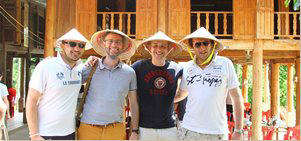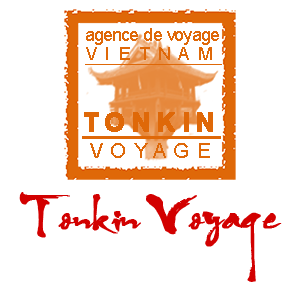Hai Phong, municipality directly under the central government, is the third most populous city in Vietnam after Hanoi and Ho Chi Minh City.
Hai Phong is a large port open to international shipping lanes and popular for hundreds of years by Chinese, Japanese, French, Spanish, Portuguese merchant ships, etc. The city and its environs, still very rural, stretch an area of 1,519km2 and have approximately 1.8 mullion inhabitants. The city is flat installed along a river and not in the sea as we thought.
Unlike the South and the capital city, connected by a highway of 110km, Hai Phong is a quiet town despite population concentration and important economic role it plays and will play in the North-eastern (foreign trade, shipbuilding, light industry). Nicknamed as the city of red flamboyant, this estuary city keeps a slow pace of life, like the speed of a ship entering or leaving the port, as evidenced by the very large amount of bikes in the streets. Its inhabitants whose lifestyle is closer, paradoxically that of Saigonais (spendthrift, jovial, very open) than that of Hanoian (thrifty, reserved and cold) and particularly friendly and welcoming.
But behind this quiet and pleasant face, Hai Phong has a much checkered history, marked by the warriors fighting, which is due to its militarily strategic position. It was first the scene of bloody battles against northern invaders, battles ended with the resounding against Han in 938, that of Le Dai Hanh against the Song in 981 and that of General Tran Hung Dao, who settled at low tide the famous piles on Bach Dang River, by running the Mongol fleet. Indochina became prime harbor in 1883 on order of Jules Ferry; Hai Phong was used during World War II by the Japanese to return their countries raw materials looted in Indochina. In 1946, the French Navy, following a customs incident, fired on the boats of Viet Minh. In the same year, the city was bombed by the French forces on the orders of Admiral Thierry Argenlieu. These events triggered while the Indochina War, which ended with the defeat of French troops at Dien Bien Phu in 1954, failure leading to withdrawal of these, via the port of Hai Phong. In 1965 and 1972, the city transit port for war material from Soviet was again the subject of heavy American bombing.
Today, Hai Phong is both a shopping center, an industrial city and a crossroads of important communication. Hai Phong is also an important tourist destination of Vietnam. It is home to tourist sites and areas of international stature such as tourist complex with Do Son 4-star resort, casino and golf courses; The Hon Dau Resort with its wave pool with sea water, the largest in Asia; intramural resorts of Song Gia and Camela; Tien Lang Spa, Cat Ba Island Resort and Spa on Cat Ba Island, etc. Still wild, it attracts a lot of foreign travelers.
Sites in Hai Phong
Do Son Resort, white sand beach lined with green casuarinas
Do Son is a popular resort located 120km from Hanoi and 20km from the city center of Hai Phong. It is a small peninsula surrounded by hills, with white sand beaches lined with casuarina trees. The resort is dominates by a hill with pine trees 125 meters high which is called the Mount of Nine Dragons, was chosen by Bao Dai, the last emperor of the Nguyen Dynasty (1802 to 1945), the abdication in 1945 marked the end of the feudal regime in Vietnam, for the installation of one of his homes. It also remains a villa Bao Dai. At the top of another hill directly overlooking the sea, there is the largest hotel in the city. The latter, whose architecture is rather gothic housing the first casino licensed by the Vietnamese government.
Today, Do Son is known for its casino, the only one in Vietnam, as well as golf courses with international standards.
Cat Ba Island, World Biosphere Reserve
Cat Ba is the largest island of the homonymous archipelago of about 370 small islands. It is known for its beaches and karst landforms that shelter the last Yellow-headed langurs, a rare species of primate in the world and endemic to the island.
This limestone island is 48km to the east of Hai Phong (2.5h boat cruise) and about twenty kilometers south of the famous Halong Bay. Being a national park where live wild animals of 32 species, 69 bird species and 20 species of reptiles and amphibians, it is a particularly attractive destination that deserves a stopover after visiting the eighth wonder of the world.
A foreign tourist noted in the Guestbook of the Park Visitor Center: “ I had heard praise the beauty of Cat Ba before going there. And yet, I gasped when I saw for the first time these high gray cliffs dripping forest.”
Recognized as World Biosphere Reserve by UNESCO in 2004, Cat Ba National Park, which covers 4,200ha of sea space and 9,800ha of forest, has something to fascinate you: fiords sleeping between cliffs and small yellow sand beaches to clear water, caves with steep rocks. The beautiful body of water called “Frog Lake” is the heart of the high-altitude rainforest reservoir for animals and plants. This land was also deemed to be the refuge of pirates in 1893 rebels and patriots moving the Red River Delta to the shores.
A legend explains the topography of the archipelago whose geological formation dating back to the end of the primary era. Once a monster fish caused terrible havoc to the people at Bach Dang mouth. The young and beautiful genius – Heavenly Fish – straddling a yellow dragon engaged in single combat with the monster battle that lasted all summer. The dragon exhausted and died; his body was pushed by the waves to a strike in Cat Ba, currently named Phu Long strike (Floating Dragon). The divine knight jumped to a place called “Landing of Talon” (Bến Gót). There he killed the monster and threw his sword and club into the sea that became the island of Sword (Hòn Gươm) and Mace (Hòn Chùy). He married a fairy from Heaven on the back of an elephant and she brought a sacred water gourd owed to supply these forces and saline land in freshwater. The elephant turned to Elephant Head Mountain (Núi Đầu Voi) while the couple, giving up heavenly life, led an earthly life devoted to fishing and gathering forest fruits.
Hon Dau Island, sacred place of local residents
Hon Dau is a small island located one kilometer southeast of Do Son. Unlike the noisy and flashy Do Son, Hon Dau features old-fashioned charm with prickly secular Benjamin, the temple dedicated to Nam Hai Vuong – a general of the Tran Dynasty (1225-1413) – and its lead of more than a hundred years. Locals consider their “rock” as a sacred place to point that no one would dare remove and change anything, even rock or tree branch. No wonder then that the island has remained untouched, virgin brutal amenities such as can be seen elsewhere on the coast…
Du Hang Pagoda, discovery of an ancient Buddhist manuscript
This national historic heritage is 2km to the south of downtown. Du Hang Pagoda was built under the reign of the Le Dynasty (980-1009) and restored several times. It is reported that Tran Nhan Tong King (1258 – 1308), a great follower of Buddhism, came to teach Buddhist theories in places. The pagoda still has many relics including Buddha statues, urns, bronze bells and gongs and the prayer book Trang A Ham, which is an ancient Buddhist manuscript.
Hang Kenh Communal House, “home of dragons”
Built in 1717 and located at the current site in 1841, it is also known under the name of Nhan Tho (humanism and longevity). Its reputation is due to its beautiful wood carvings with a total of 156 rooms, with the dragon as basic theme. There are 308 dragons of different shapes and sizes. The pagoda is also a statute of King Ngo Quyen and a former palanquin.
Like all other communal houses in Vietnam, it is dedicated to the founder and geniuses of the village. It was long a place dedicated to social activities of the village community: It is here that were, in feudal times, meetings of notables and registered males of the village, that treated the administrative issues (breakdown taxes and communal lands, recruit soldiers, assigning chores…) and justice (settlement of disputes, punishment for those who violate the requirements of customary village).
The annual sacrifice in honor of the spirits is celebrated 16 to 18 February (lunar calendar). It results in solemn ceremonies and numerous festivals in its large courtyard that cheers up people: chess, traditional operas, wrestling, cock fighting, swing, etc.
Municipal Theatre Square, a French architecture in Vietnam
Located in Hong Bang district, Hai Phong City, the Theatre Square is where large gatherings and important events are organized. Built in 1904 by materials imported from France, the theatre is inspired by the architecture of French operas built in the Average Age. The vaulted ceiling is decorated with flowers and bears the name of famous European artists Mozart, Beethoven, Moliere, etc. This 2-storey building with 100 doors and windows, corridors, halls, and a 400-seat room, whose ceiling is decorated with floral frescoes displaying the names of writers and famous artists. On the second floor, we discover vault doors of the Gothic art.
The beauty outside the theater represents the development of a modern society: a large square in front of the flower garden, a fountain, lamps shimmering stretch of flamboyant branches. The harmonious combination of seniority and modernity creates a magnificent theater, impressive and attractive for visitors.
The Central Market, iron market
This is the biggest market Hai Phong City and used to be called An Bien Fair. When the city was established in 1888, this market was built, divided into large sections, with cement floors and materials such as iron and steel. That’s where it gets its name, “Sắt” mean “Iron” in Vietnamese. The central market was located at the confluence of the rivers Cam and Tam Bac and has long been a bustling trading center of the whole region. Rebuilt in 1992, the central market has currently become a high six-storey shopping center with more than two thousand stands for the first three floors. The three upper floors house hotel rooms, restaurants, a nightclub and representative offices. In short, it’s a real mess.
Place of interest
-
Northern Vietnam
- Where & When to visit the rice terraces in North Vietnam
- Huong Pagoda – Pilgrimage to the land of Buddhas
- Day Trips from Hanoi
- Things to do in Hanoi
- Hanoi, City of Peace
- Ninh Binh Province
- Bat Trang, ceramic art destination
- Duong Lam ancient village
- Tay Phuong Pagoda, the destination to calm down
- Cat Ba Island, World Biosphere Reserve
- Central Vietnam
- Southern Vietnam






